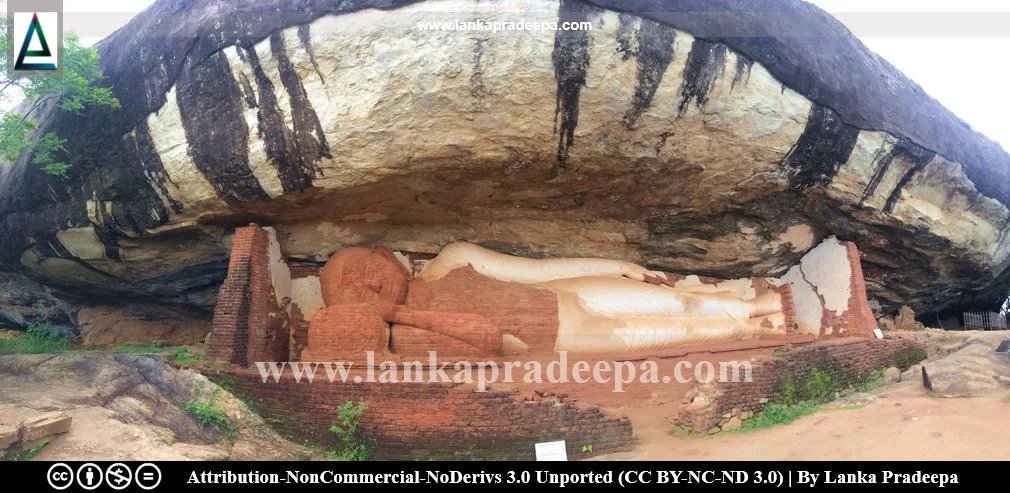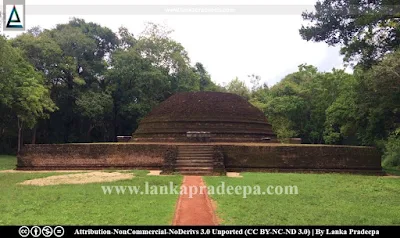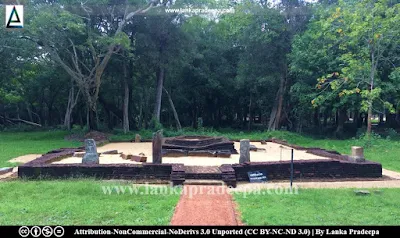
Pidurangala Viharaya, also known as Piduragala Cave Temple (පිදුරංගල විහාරය), is a Buddhist temple situated near the famous Sigiriya Fortress in Matale District, Sri Lanka. The ruins of the ancient monastery are found scattered over acres on both the summit and the foot of Pidurangala rock which rises to a height of 340 m (1,115.49 ft.) above mean sea level.
Etymology
According to the view of some, the name "Pidurangala" has been derived from the "Piduran mila nindan gala" (Abeywardana, 2004).
History
The history of Pidurangala runs back to the pre-Christian era. Several Early Brahmi Inscriptions belonging to the 3rd century B.C. - 1st century A.D. have been found inscribed on the brows of the rock caves located within the temple premises. The present Pidurangala temple complex is attributed to King Kashyapa of Sigiriya [(475-497 A.D.) Abeywardana, 2004].
Also, inscriptions belonging to the 6-7th, and 10th centuries A.D. have been discovered at the site. A marble plaque containing three statues of Buddhas that was found in Pidurangala is presently on display at the Anuradhapura Period gallery of Colombo National Museum and that artefact has been dated by scholars to the 7th century A.D. Some of the structures in the monastery complex located at the lower terrace of the Pidurangala rock are believed to be works of the 8th century A.D. (Wijebandara, 2011).
Inscriptions
A large number of inscriptions (cave, rock, Vaharala, and Attani) have been found on the Pidurangala Vihara premises (Wijebandara, 2011).
Pidurangala cave inscriptions
Script: Early Brahmi
Language: Old Sinhala
Content: The cave of lord Pussa.
Reference: The information board at the site by the Department of Archaeology and the Ministry of National Heritage
Period: 2nd century B.C. - 1st century A.D.
Script: Early Brahmi
Language: Old Sinhala
Content: The cave of Tissadevi, daughter of Majjhima, son of Siva of Kolagama is given to the Sangha (Buddhist monks). The co-donor with Tissadevi is Mandana, wife of Vima-Naga of Garadidagama.
Reference: Paranavitana, 1970.
Period: 6th - 7th centuries A.D. Script: Later Brahmi Language: Old Sinhala
Content: Records about construction on top of the cave by Ven. Abhaya, the monk of Tatayaka.
Reference: Dias, 1991.
Pidurangala rock inscription
This inscription is found on the rock in front of the cave containing the large reclining Buddha image. It was copied in 1931 by the Department of Archaeology (Dias, 1991).
Script: Transitional Brahmi
Language: Old Sinhala
Content: Records about the donations of one Amuna of paddy fields and Kahavanu coins by a mason Dalaganayunaka.
Reference: The information board at the site by the Department of Archaeology and the Ministry of National Heritage.
Pidurangala Vaharala inscriptions
A number of inscriptions of the Vaharala type have been identified at the site. They record the freeing of slaves from their compulsory services, by donation of money and lands to the Vihara. Most of these inscriptions belong to the 6th7th century A.D. and have been written in the Old Sinhala language using the Transitional-Brahmi scripts.
Pidurangala Attani inscription
An Attani inscription probably belonging to King Dappula IV (924-935 A.D.) has been found on the Pidurangala temple premises (Wijebandara, 2011).
Pidurangala Attani inscription
An Attani inscription probably belonging to King Dappula IV (924-935 A.D.) has been found on the Pidurangala temple premises (Wijebandara, 2011).
The temple complex
Lower Vihara complex
The Vihara complex at the lower terrace of the Pidurangala temple has been identified as a temple belonging to the Pabbatharama tradition (Wijebandara, 2011). As a part of that tradition, five main ritual buildings known as Panchavasa are found in the temple complex (Wijebandara, 2011). These five buildings include the Stupa, Bodhighara (Bodhi-tree shrine), Uposathaghara (chapter house), Patimaghara (image house), and Sabha [(or Mandapa) Wijebandara, 2011].
Stupa
The Stupa which was in a dilapidated state was excavated in 1951 (Wijebandara, 2011). It has been built on an elevated square-shaped platform and can be accessed through four flights of steps constructed in each direction. The platform is about 6 ft tall and each side has a length of 80 ft (Wijebandara, 2011). The Stupa rises upward about 16 ft from the platform and the diameter of its base is about 50 ft (Wijebandara, 2011).
The archaeological excavations revealed that the relic chamber of the Stupa was a work in the 8th century A.D. (Wijebandara, 2011). This was further confirmed by a brass casket found in the chamber (Wijebandara, 2011). However, further excavations had exposed the evidence of an old relic chamber below the first chamber. According to the view of scholars, the present Stupa has been built over an ancient Stupa (the original Stupa) and its relics have been moved to the new relic chamber during the later renovation (Wijebandara, 2011).
The deep excavation of the Stupa revealed fragments of charcoal and burnt soil at the ground level (Wijebandara, 2011). Therefore, scholars thought that this Stupa had been built over a funeral pyre as in the case of Dakkhina Thupa at Anuradhapura. Also, the bricks used to construct the original Pidurangala Stupa are similar in size to the bricks found in the ruins in Pramuda-vanaya located west of the Sigiriya rock (Wijebandara, 2011). Therefore, it is assumed that the original Piduangala Stupa was built during the period of Sigiriya (Wijebandara, 2011). Paranavitana believed that this Stupa was probably built over the funeral pyre of King Kashyapa of Sigiriya (Nicholas, 1963).
The excavated Stupa was conserved in 1953 (Wijebandara, 2011).
Bodhighara
Bodhigharas are shrines constructed in Buddhist temples to venerate the Bodhi tree. The ruined Bodhighara found in the Pidurangala temple is a square-shaped building with four entrances on each side. The entrances are decorated with plain Sandakada Pahana (moonstones) and Mura-gala (guard stones). In the middle of the building is a circular-shaped podium that was once the ground for the Bodhi tree. Although there is no Bodhi tree today, it provides evidence of the presence of a Bodhi tree in the past. The pieces of roof tiles found during the excavations revealed that this shrine once had a roof around the Bodhi tree (Wijebandara, 2011). A few stone pillars probably used to hold the roof is still found around the ruined shrine.
Uposathaghara
 Uposathaghara was the chapter house of this temple complex. The remaining building is 73 ft 6 inches in length and 43 ft 9 inches in width (Wijebandara, 2011).
Uposathaghara was the chapter house of this temple complex. The remaining building is 73 ft 6 inches in length and 43 ft 9 inches in width (Wijebandara, 2011).
Several large stone pillars are found in the present building. The pillars are about 10 ft tall and have been symmetrically fixed to the ground.
Patimaghara
The ruined Patimaghara (or the image house) building was first excavated during 1989-1991 and again during 2000-2002 (Wijebandara, 2011). The building is 107 ft 8 inches long and 69 ft wide (Wijebandara, 2011). A faded inscription has been found on the Sandakada Pahana (the moonstone) fixed at the entrance of the image house (Wijebandara, 2011).
The Antaralaya part of the image house is 107 ft. 8 inches in length and 67 ft. in width (Wijebandara, 2011). Seven inscriptions known as Vaharala are found on a step of the Antaralaya part (Wijebandara, 2011). Of them, one inscription contains the ancient name of this temple as "Dala Vahara" [("Dala Vehera or Data Viharaya") Wijebandara, 2011].
This building was conserved during 2003-2004 (Wijebandara, 2011).
Mandapa
Mandapa, also known as Sabhawa is one of the buildings belonging to the Panchavasa complex. It has been constructed between the other four buildings; the Stupa, Bodhighara, Uposathaghara, and Patimaghara.
This is a square-shaped building (54 ft x 54 ft) with four entrances on each side (Wijebandara, 2011). Plain Sandakada Pahana, Muragala, and Korawak Gala (wingstones) are found at each entrance. A few Vaharala inscriptions are also found engraved on the steps of one of the entrances. Evidence is there to prove that this building has been renovated on two occasions (Wijebandara, 2011).
Upper Vihara complex
A large number of Buddhist monuments are found on the summit as well as at the base of the Pidurangala rock (Wijebandara, 2011).
Stupas at the summit of the Pidurangala rock
Ruins of two Stupas built adjacent to each other are identified at the summit of the Pidurangala rock. Both Stupas are presently at a statue of ruins.
The reclining Buddha statue
A large reclining Buddha statue is found sculpted in a drip-ledged rock cave located on the eastern side of the Pidurangala rock. The brick-built statue is about 42 ft long and believed to be a work belonging to the 4th-5th century A.D. (Wijebandara, 2011). The construction of this statue is attributed to King Kashyapa of Sigiriya (Wijebandara, 2011).
The statue had been destroyed by thieves who searched for treasures inside it. However, it was restored to the present state by the Department of Archaeology during a conservation process carried out in 2001-2002 (Wijebandara, 2011).
The freshwater pond which is located close to this cave is believed to have been used by Buddhist monks.
The cave temple
The cave temple (Len Viharaya) which is situated in the shadow of the Pidurangala rock is said to be about 150 years old (Wijebandara, 2011). Two standing Buddha statues which are believed to have been brought from outside are found inside the cave temple. These two images according to some, are two limestone statues that had been unearthed from an excavation done at the Panchawasa complex [(lower temple complex) Wijebandara, 2011]. A reclining Buddha belonging to the Kandyan Period is also found inside the cave temple.
Archaeological Museum
A small site museum of the Archaeological Department has been established on the
premises of Pidurangala Viharaya. The museum is used to exhibit antiquities
recovered from the temple.
As a famous location for photography
Pidurangala is an isolated rock with a height of 340 m (Wijebandara, 2011). As it is located adjacent to the ancient Sigiriya fortress, a picturesque view of Sigiriya can be captured from the summit of the Pidurangala rock.
 .
.Do you know?
References
1) Abeywardana, H.A.P., 2004. Heritage of Kandurata: Major natural, cultural and historic sites. Colombo: The Central Bank of Sri Lanka. pp.182-183.
2) Dias, M., 1991. Epigraphical notes (Nos 1 -18). Colombo: Department of Archaeology. pp.33-34,85,.
3) Nicholas, C. W., 1963. Historical topography of ancient and medieval Ceylon. Journal of the Ceylon Branch of the Royal Asiatic Society, New Series (Vol VI). Special Number: Colombo. Royal Asiatic Society (Ceylon Branch). p.110.
4) Paranavitana, S., 1970. Inscription of Ceylon (Vol. I). Department of Archaeology Ceylon. p.67.
5) Wijebandara, I.D.M., 2011. Aithihasika Pidurangala (In Sinhala). Department of Archaeology. ISBN: 978-955-9159-65-0. pp.iii,5,14-35.
2) Dias, M., 1991. Epigraphical notes (Nos 1 -18). Colombo: Department of Archaeology. pp.33-34,85,.
3) Nicholas, C. W., 1963. Historical topography of ancient and medieval Ceylon. Journal of the Ceylon Branch of the Royal Asiatic Society, New Series (Vol VI). Special Number: Colombo. Royal Asiatic Society (Ceylon Branch). p.110.
4) Paranavitana, S., 1970. Inscription of Ceylon (Vol. I). Department of Archaeology Ceylon. p.67.
5) Wijebandara, I.D.M., 2011. Aithihasika Pidurangala (In Sinhala). Department of Archaeology. ISBN: 978-955-9159-65-0. pp.iii,5,14-35.
Location Map
This page was last updated on 30 July 2023









